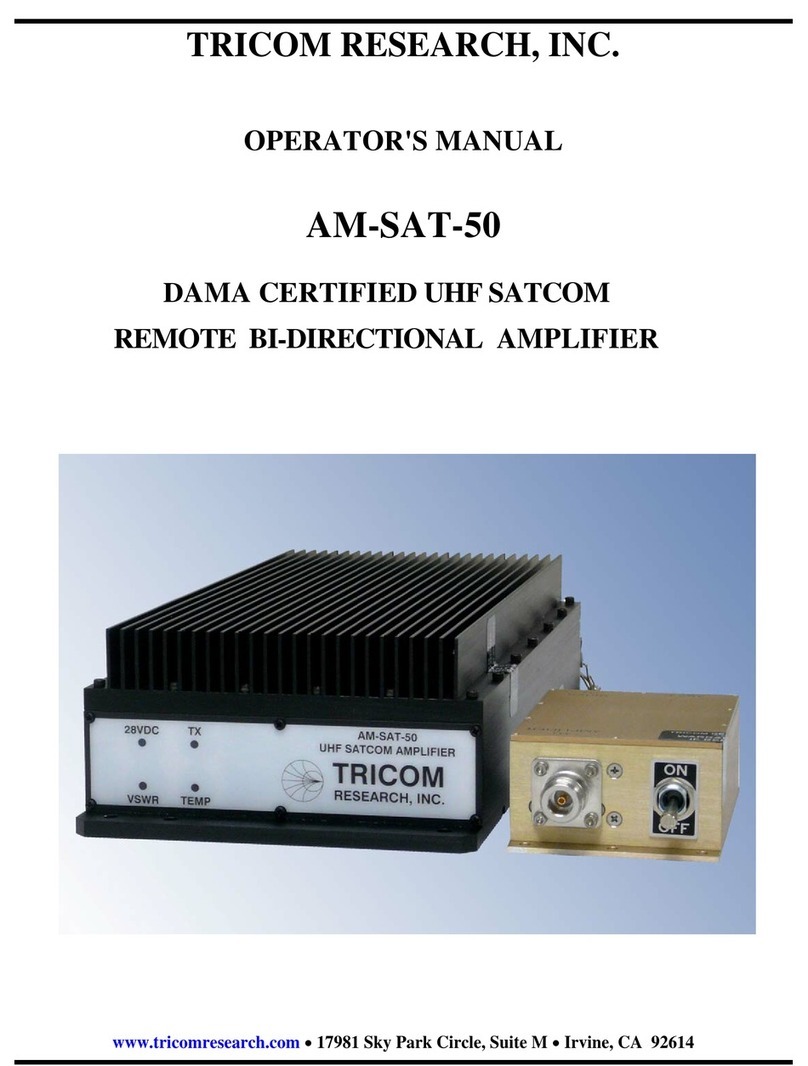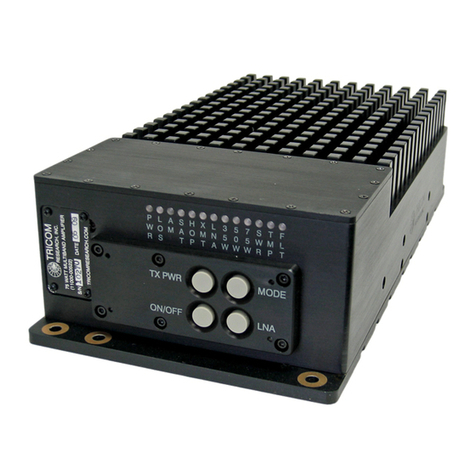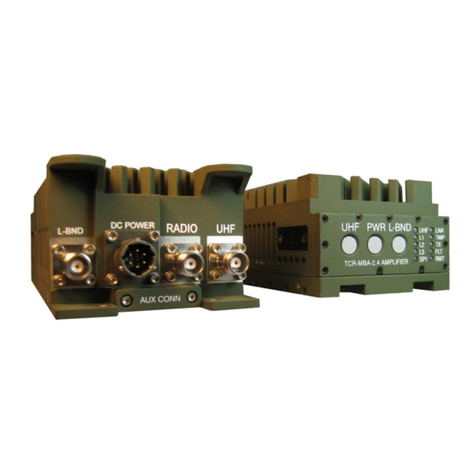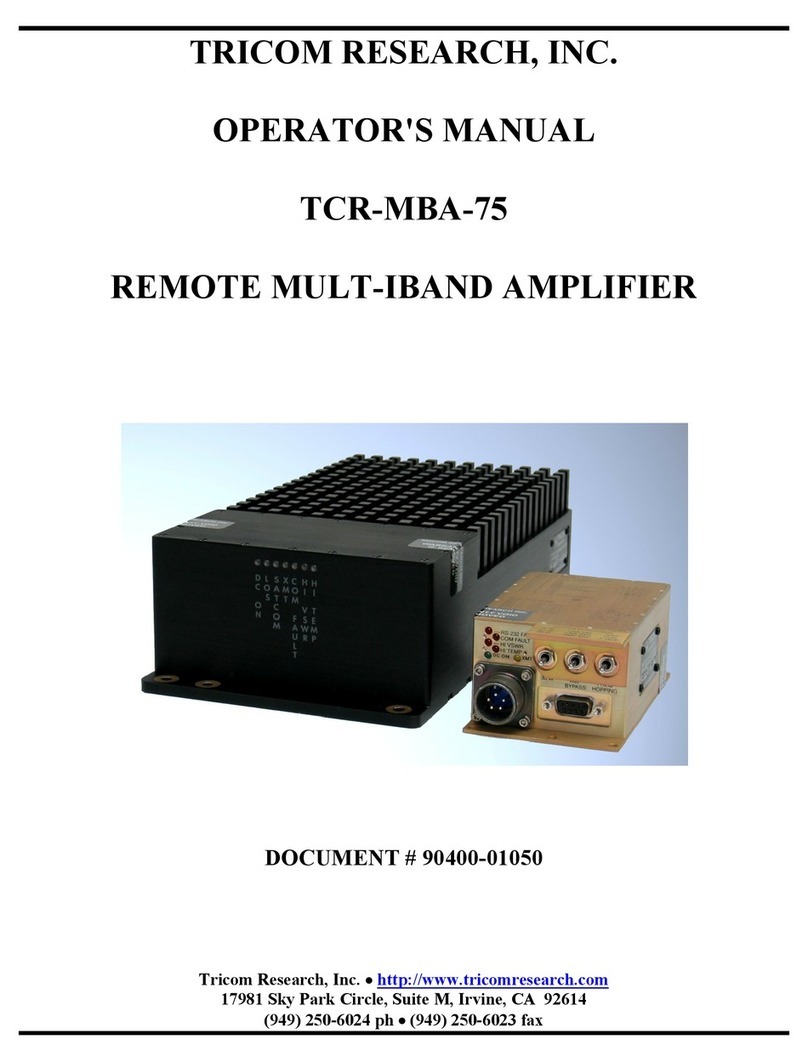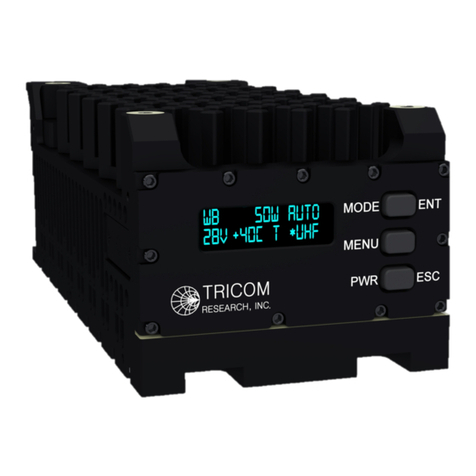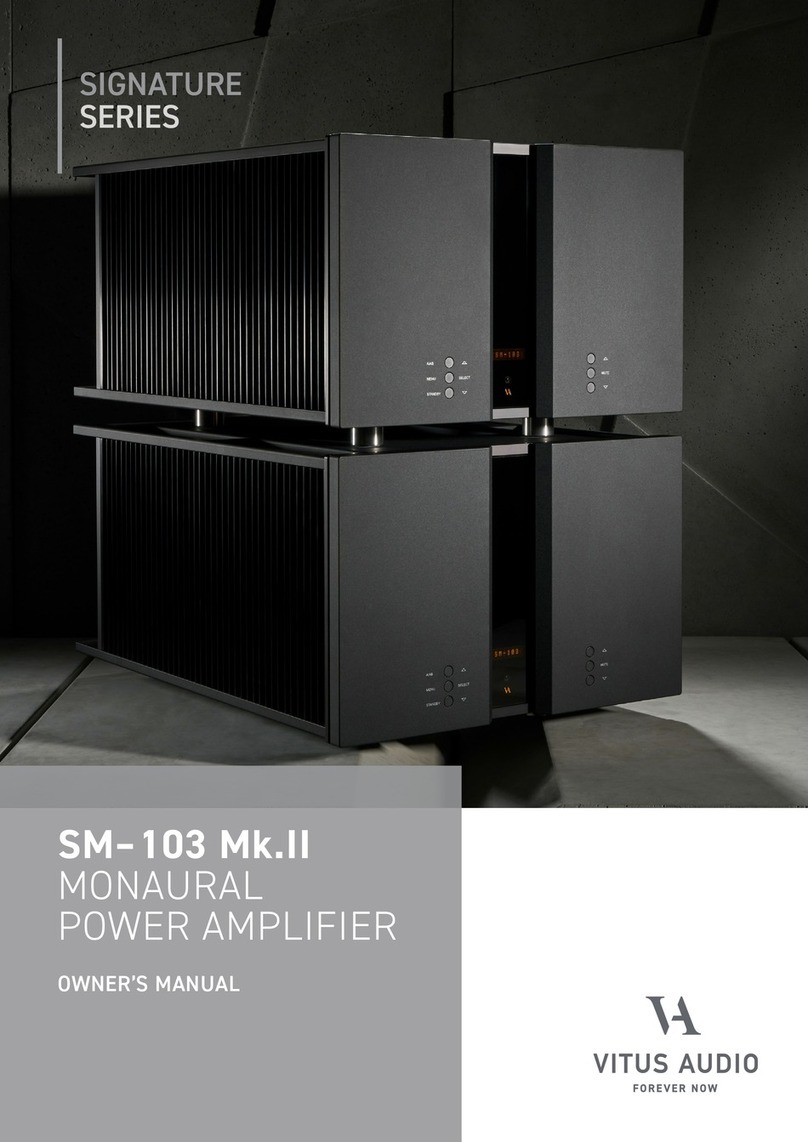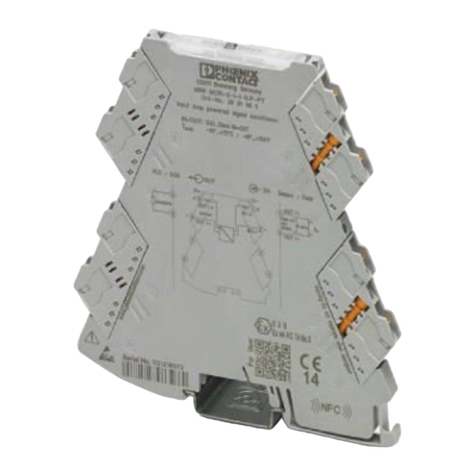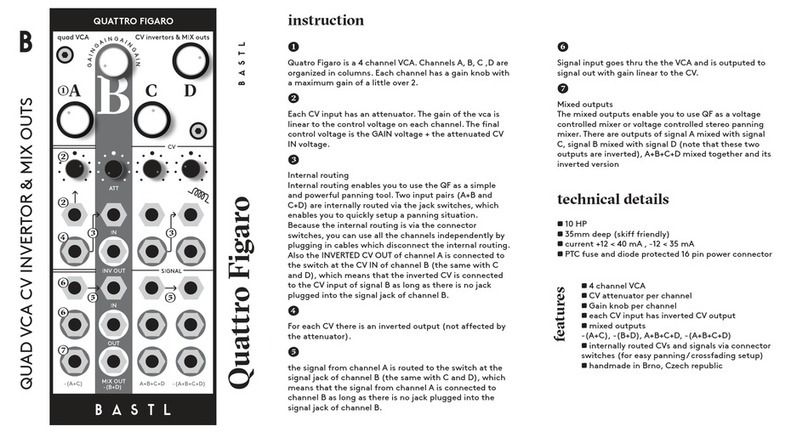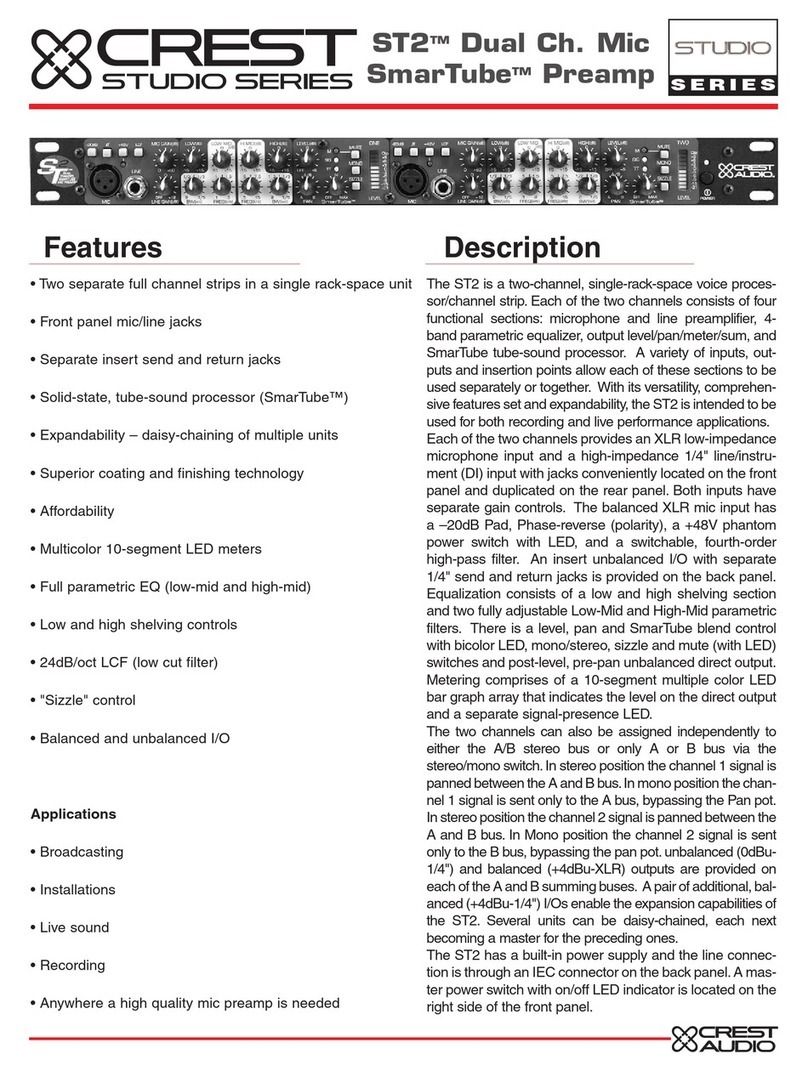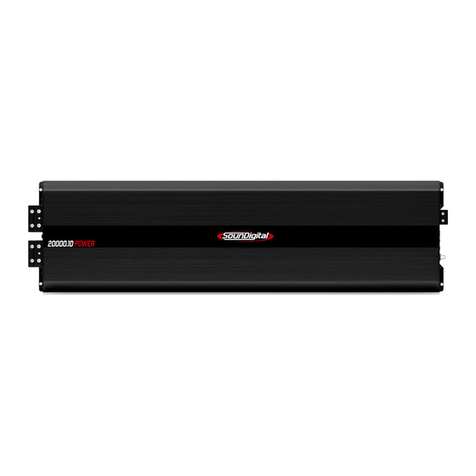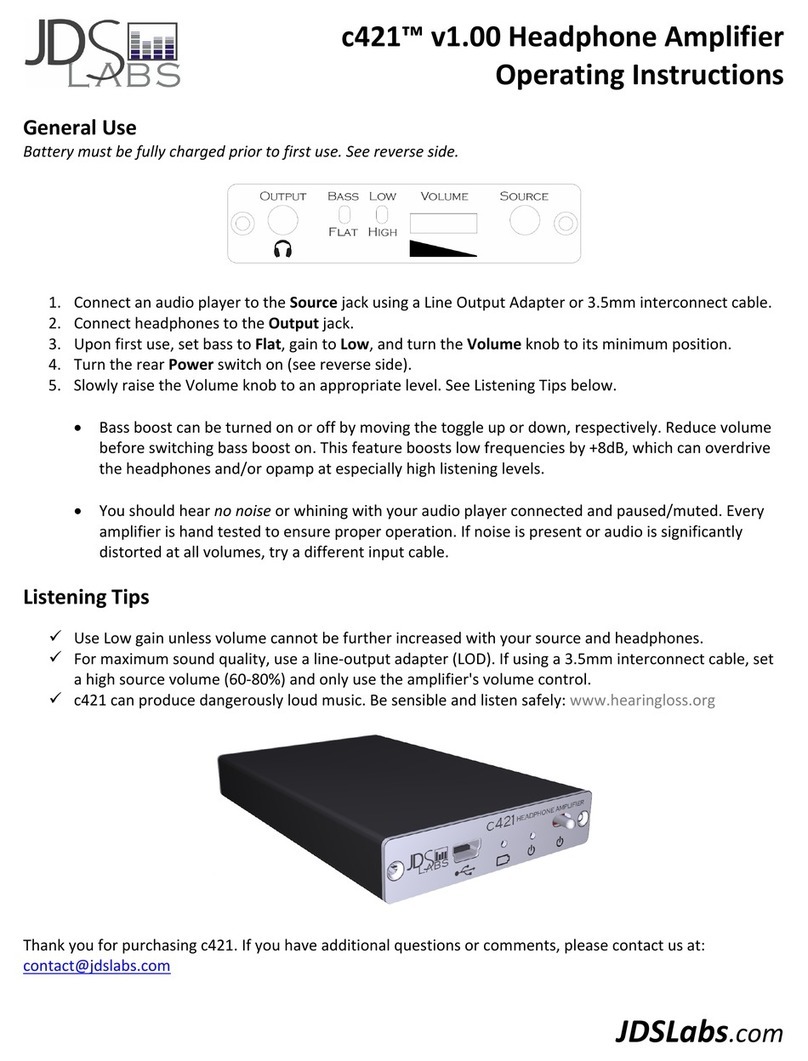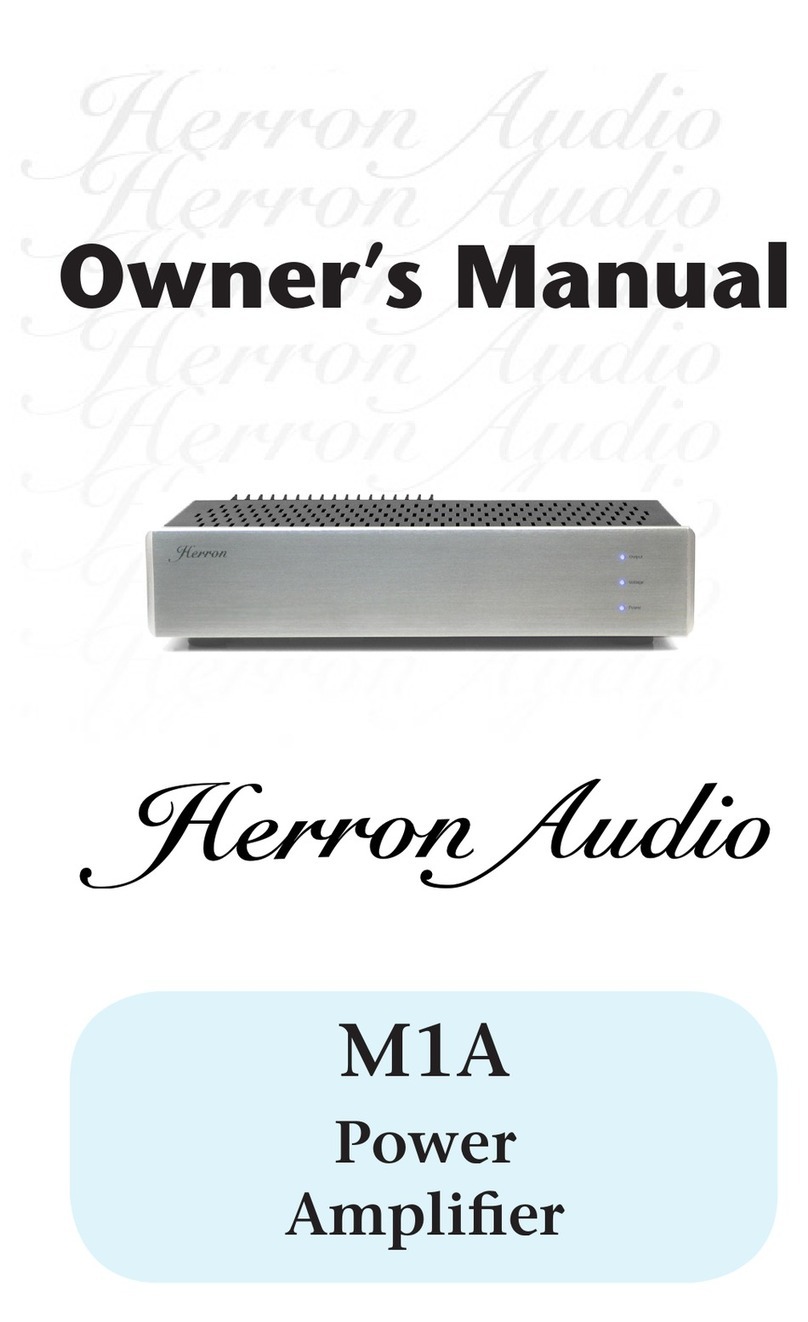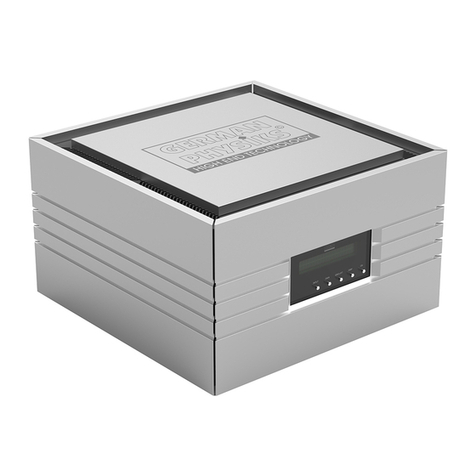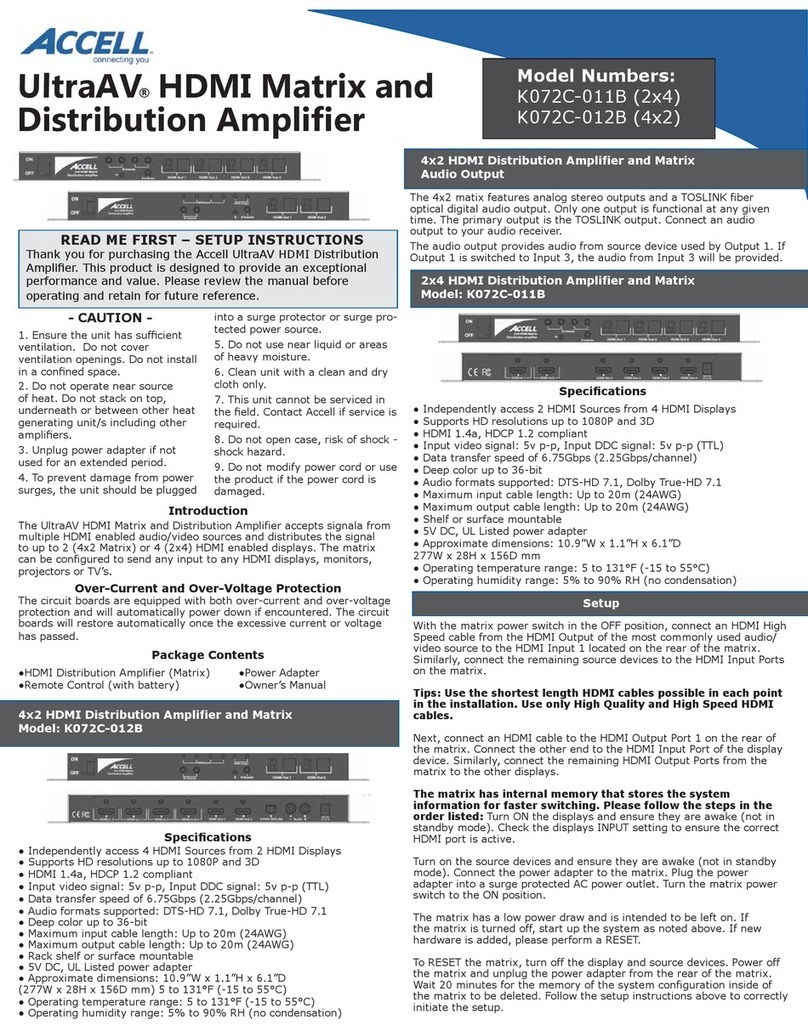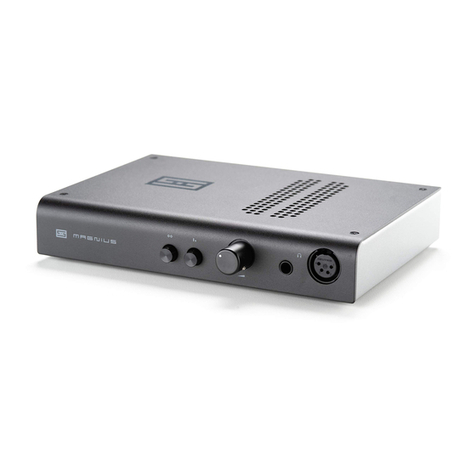TriCom TCR-MBA-50 WB User manual

OPERATOR'S MANUAL
TCR-MBA-50
MULTI-BAND RF AMPLIFIER
DOCUMENT # 90400-01102
Tricom Research, Inc. http://www.tricomresearch.com
17981 Sky Park Circle, Suite M, Irvine, CA 92614
Ph: (949) 250-6024 fax: (949) 250-6023

TCR-MBA-50 OPERATOR’S MANUAL
i
Revision History - Document 90400-01102
Revision Description Date
P1 Preliminary Release 4 Aug 2011
P2 Preliminary Release 9 Aug 2011
P3 Preliminary Release 23 Aug 2011
P4 Preliminary Release – changed outline drawings 7 Nov 2011
P5 Preliminary Release – added Appendix A 16 Dec 2011
P6 Preliminary Release – Updated Mounting Hole
Information 26 Jan 2012
P7 Preliminary Release – Updated BNC Connector
Dimensions, Cover Page Figure, Figure 1 and Figure 2 31 Jan 2012
P8 Preliminary Release – Added Auxiliary connector and
remote control cable pinouts 15 Feb 2012

TCR-MBA-50 OPERATOR’S MANUAL
ii
TABLE OF CONTENTS
1.0 INTRODUCTION
1.1 General Information.......................................................................................1
1.2 Abbreviations and Glossary...........................................................................2
1.3 Equipment Description ..................................................................................3-6
1.4 Features..........................................................................................................7
1.5 TCR-MBA-50 System...................................................................................7
1.5.1 Amplifier Components...................................................................................7
1.5.2 Power Cable...................................................................................................7
1.6 Specifications.................................................................................................8-9
2.0 OPERATION
2.1 General Information.......................................................................................11
2.2 Controls, Indicators, and Connectors.............................................................11-13
2.3 Operation........................................................................................................13
2.3.1 General Information.......................................................................................13
2.3.2 Equipment Set-up...........................................................................................13
2.3.3 Operating Procedures.....................................................................................13
2.3.3.1 Push Button Switch Operation.......................................................................13-14
2.3.3.2 LNA Operation Precautions...........................................................................14
2.3.3.3 Remote Control Operation.............................................................................15
2.3.3.4 Out of Band Operation...................................................................................15
2.3.3.5 Bypass Operation...........................................................................................15
2.3.3.6 Troubleshooting.............................................................................................15-16
3.0 INSTALLATION
3.1 General Information.......................................................................................17
3.2 Preparation for Use........................................................................................17
3.3 Mounting Provisions......................................................................................17
3.4 DC Input Power .............................................................................................19
3.5 RF Interconnections.......................................................................................19
3.6 Remote Control Interface...............................................................................21
3.7 Remote Control Command Set......................................................................23

TCR-MBA-50 OPERATOR’S MANUAL
iii
LIST OF TABLES
Table 1-1 Nominal Performance Specifications ......................................................8
Table 1-2 Interconnect Characteristics.....................................................................10
Table 2-1 Mode Indicators.......................................................................................12
Table 2-2 Power Output Level Indicators................................................................12
Table 2-3 Front Panel Controls................................................................................13
Table 2-4 I/O Connectors.........................................................................................13
Table 2-5 Troubleshooting Guide ............................................................................16
Table 3-1 DC Input Power Connector Pinout..........................................................19
Table 3-2 DC Input Power Control Pin Functions...................................................19
Table 3-3 Auxiliary Connector Pinout.....................................................................21
Table 3-4 Remote Control Command Set................................................................23
LIST OF FIGURES
Figure 1-1 TCR-MBA-50 System Components........................................................1
Figure 2-1 Amplifier Controls & Indicators..............................................................11
Figure 2-2 Amplifier Connections.............................................................................11
Figure 3-1 TCR-MBA-50 Outline Drawing..............................................................18
Figure 3-2 Amplifier DC Input Connector................................................................19
Figure 3-3 Commercial Vehicle DC Power Cable....................................................20
Figure 3-4 Military Vehicle DC Power Cable...........................................................20
Figure 3-5 Military Battery DC Power Cable............................................................20
Figure 3-6 Auxiliary Connector Pinout.....................................................................21
Figure 3-7 USB Remote Control Cable.....................................................................22
Figure 3-8 RS-232 Remote Control Cable ................................................................22
Appendix A MS Windows Serial Comm Port Reassignment......................................24
Note: The information contained herein is for reference only and does not constitute a
warranty of performance.

1
1.0 INTRODUCTION
1.1 GENERAL INFORMATION
This manual provides operating instructions for the TCR-MBA-50 Multiband
Amplifier shown in Figure 1-1. The TCR-MBA-50 is an amplifier/pre-amplifier
designed to provide transmit and receive gain for the following modes of
operation:
Multiband line of sight (LOS FM and AM) 30~512 MHz communications
SINCGARS frequency hopping 30~88 MHz operation
HAVE QUICK frequency hopping 225~400 MHz
UHF Tactical SATCOM (242~268 MHz receive and 292~318 MHz
transmit) frequencies with Low Noise Amplifier (LNA) and Cosite
suppression.
Figure 1-1. TCR-MBA-50 System Components

2
1.2 ABBREVIATIONS AND GLOSSARY
AGC Automatic gain control
ALC Automatic level control
AM Amplitude modulation
ANT Antenna
BPS Bits per second
CT Cipher text
CW Continuous wave
COMSEC Communications security
dB Decibel
dBm Decibel referenced to 1 milliwatt (0 dBm = 1 mW)
FM Frequency modulation
Hz Hertz
IW Integrated Waveform
JITC Joint Interoperability Test Center (DISA)
KHz Kilohertz
LED Light emitting diode
LNA Low Noise Amplifier
LOS Line of sight
MHz Megahertz
mW Milliwatt
PT Plain text
PTT Push to Talk
RCV Receive
SATCOM Satellite Communications
UHF Ultra-high frequency
VDC Volts, direct current
VSWR Voltage standing wave ratio
W Watt
XMT Transmit

3
1.3 EQUIPMENT DESCRIPTION
The TCR-MBA-50 is a bi-directional half duplex RF Power Amplifier that provides
transmit amplification for the 30-512 MHz FM/AM Line-of Sight (LOS), 30-88 MHz FM
SINCGARS Frequency Hopping, 225-400 MHz AM HAVE QUICK Frequency
Hopping, and the 292-318 MHz FM UHF Tactical SATCOM bands; it can also provide
receive amplification for the 242-268 MHz receive FM UHF Tactical SATCOM band. It
is suitable for, vehicular, airborne, or fixed-station applications and is compatible with
most military and commercial radios operating in the 30-512 MHz frequency spectrum.
The operation of the amplifier can be controlled via front panel switches or a USB or
serial interface for remote control operation. The amplifier has a single power
connection, an RF input port and two frequency specific output antenna ports. The LOS
port is for frequency hopping and multiband Line of Site operation anywhere between 30
and 512 MHz. The SATCOM port is used with UHF SATCOM antennas.
1.3.1 USER SET MODES.
The following modes are available to the user with the push buttons or with the remote
interface:
LOS MODE BUTTON
LOS FM
FREQUENCY HOP FM
LOS AM
FREQUENCY HOP AM
SAT MODE BUTTON
SATCOM LNA ON
SATCOM LNA OFF
The mode buttons determine which output antenna port is active. If the LOS button is
pressed while the amplifier is in a SATCOM mode, the amplifier will return to the last
used LOS mode. The next LOS button press will sequence to the next available LOS
mode. The same is true for a SAT button press while in LOS mode. This way, a user
may simply toggle between set SATCOM and LOS modes by alternately pressing the
two mode control buttons, without having to fall all the way through the menu structure.
1.3.2 TRANSMIT POWER LEVELS.
The PA has two nominal RF output power levels for LOS, 25 and 50 Watts and 5
nominal RF output power levels for SATCOM, 10, 15, 25, 35 and 50 Watts to comply
with MIL-STD-188-181b 2 dB RF output adjustments. These are nominal power levels
only, as other restrictions, including input voltage, source current limitations, and input
power levels may cause the PA to output less than the nominal levels. The nominal
transmit power level is selected by the DC input mode as listed in Table 1-1, the user

4
power ON/OFF button on the front panel keypad and optionally by the remote control
interface. The DC input pins, by indicating the maximum allowable current draw, will
set the maximum allowable output power. The PWR button or the remote interface will
then be able to select from the allowable output power levels.
a. Military Battery Mode (12 VDC nominal):
25 Watts in LOS and 10, 15 or 25 Watts in SATCOM regardless of input
voltage AND maximum current draw not to exceed 4.5 Amps.
b. Commercial Vehicle Mode (13.8 VDC nominal):
25 Watts in LOS and 10, 15 or 25 Watts in SATCOM regardless of input
voltage AND maximum current draw not to exceed 5.5 Amps.
c. Military Vehicle Mode (28 VDC nominal):
25 or 50 Watts in LOS and 10, 15, 25, 35 or 50 Watts in SATCOM
d. Special Mode: Reserved.
1.3.3 POWER ON, INITITALIZATION AND MODE CHANGES.
A single pushbutton switch provides for power ON/OFF cycling, RF power level control
and LED intensity control. Pressing the button momentarily (<2 seconds) will cycle
through the different power levels as described in paragraph 1.3.2. Holding the button
down will dim the LEDs in 4 steps at 1 second intervals before the PA shuts down;
releasing the PWR button before the PA shuts down will set the LED intensity at one of
the 4 levels (high, medium, medium low, low). The LOS and SATCOM mode buttons
will cycle through the operational modes described in Section 1.3.1. Non-volatile
memory will remember the last operational state and the PA will return to that state when
power is restored. If the power is lost due to DC disconnection, the PA will be in the
OFF state and will return to the last known mode when DC power is cycled back ON and
the PWR button is pressed for 1-2 seconds. If power is shut off using the PWR button,
disconnecting and restoring the DC power connection will have no effect; the PA will
remain off until the PWR button is pressed for 1-2 seconds. If PIN E on the DC input
power connector is tied to GROUND and DC power is removed and restored, the
amplifier will automatically power ON into the last known mode. This may be used in
installations where the front panel is not accessible and DC power is controlled remotely.
1.3.4 MODE OF OPERATION INDICATORS.
There are 10 front panel LED's used to indicate the different modes of operation and
power amplifier operational status. Table 2-1 describes the LED operation for the
different modes of operation and Table 2-2 describes the different power levels available
for each mode of operation.

5
1.3.4.1 SATCOM MODE INDICATOR (SAT).
The SAT LED will turn on whenever one of two SATCOM modes is selected (SAT LNA
ON, SAT LNA OFF).
1.3.4.2 LOW NOISE AMPLIFIER MODE INDICATOR (LNA).
The LNA LED will turn on whenever the SATCOM/LNA ON mode is selected (SAT
LNA ON).
1.3.4.3 LINE OF SIGHT MODE INDICATOR (LOS).
The LOS LED will turn on whenever one of four LOS modes is selected (LOS FM, LOS
FM Frequency Hopping, LOS AM, LOS AM Frequency Hopping).
1.3.4.4 FREQUENCY HOPPING MODE INDICATOR (FH).
The FH LED will turn on whenever one of two frequency hopping modes is selected
(LOS FM Frequency Hopping, LOS AM Frequency Hopping).
1.3.4.5 AMPLITUDE MODULATION MODE INDICATOR (AM).
The AM LED will turn on whenever one of two amplitude modulation modes is selected
(LOS AM, LOS AM Frequency Hopping).
1.3.4.6 RF INPUT LEVEL UNDER/OVER DRIVE (LVL).
The LVL LED indicates a condition where the amplifier is either under or over driven for
a set power level. In the case where additional RF output from the radio is needed, the
LVL LED will flash slowly (2 Hz). If the amplifier is being over driven the LVL LED
will flash rapidly (5 Hz). The LVL LED may also flash rapidly in conjunction with a
high temperature alarm, indicating that the RF output from the radio should be reduced.
After the high temperature alarm has been released, the LVL LED may flash slowly,
indicating that the RF output from the radio may then be increased.
Note: It is possible that some modulation formats not tested as of the current software
release date may cause erratic indication on the LVL LED – please contact the factory if
this occurs.
1.3.4.7 HIGH TEMPERATURE INDICATOR (TMP).
The TMP LED will flash whenever the PA’s temperature exceeds its normal operating
threshold.

6
1.3.4.8 TX STATUS INDICATOR (TX).
The TX LED will turn on during a good transmit condition. Depending on the duty cycle
of some data transmission waveforms such as DAMA, the TX LED may flicker. This is
due to the fast switching between transmit and receive and DOES NOT indicate a system
malfunction.
1.3.4.9 FAULT STATUS INDICATORS (FLT).
The FLT LED will flash to indicate a fault condition, such as attempting to transmit at a
frequency that is not valid in the selected mode.
1.3.4.10 REMOTE OPERATION STATUS INDICATOR (RMT).
The REMOTE LED will be on when the PA has received a REMOTE ON command
from an external terminal and will stay on until the REMOTE OFF command has been
received.
1.3.5 REMOTE CONTROL INTERFACE.
USB (+5, GND, D+ and D-) and RS-232 interfaces (GND, TXD and RXD only) will
provide remote control of the amplifier’s modes of operation and power levels. When a
terminal has been connected to the remote interface, and the proper escape sequence has
been sent by the terminal (refer to sections 3.5 and 3.6 for remote control operation) for
remote, the PA will start communications with the terminal and will light the RMT LED
on the front panel. At this point the user push buttons will become inactive, except to
power the amplifier off. The PA will NOT detect the removal of the remote interface
connection and will remain in remote control mode until the power is cycled OFF and
back ON.

7
1.4 FEATURES
The TCR-MBA-50 has the following features:
DAMA, DAMA IW and Special Communications modes of operation
compatible
Coverage from 30 to 512 MHz, including SINCGARS FM and HAVE
QUICK AM Frequency Hopping compatibility
Connections for both a SATCOM and an LOS antenna
Pre-amplification of received RF signals from antennas connected to the
SATCOM port
Power amplification of transmit signals to 25 or 50 Watts in LOS and 10, 15,
25, 35 and 50 Watts in SATCOM modes
Transmit and receive band filtering to suppress interference from
co-located radios and amplifiers in SATCOM mode
Amplifier front panel indication of system status
1.5 TCR-MBA-50 SYSTEM
The TCR-MBA-50 is pictured in Figure 1-1.
1.5.1 Amplifier Components
The Amplifier consists of several printed circuit assemblies, a filtering and switching
network, and RF connectors housed in a water resistant aluminum housing. With normal
care and maintenance, the assembly is highly resistant to corrosion from the elements.
The RF connections to the RF input and SATCOM antenna are BNC female and the RF
connection for the LOS antenna is BNC female. Power to operate the amplifier is applied
via a cable connected to the 6 pin circular DC input connector.
1.5.2 Power Cable
A multi-conductor cable connects the amplifier with an external DC power source. A
wiring diagram for the cable is shown in Section 3 of this manual. The DC power cable
used with the legacy TCR-MBA-25 power amplifier may be used to power the TCR-
MBA-50; however, the connection for the Auto Power ON Select (pin E grounded) may
have to be added (refer to paragraph 2.3.3.1 PWR push button switch operation).

8
1.6 Specifications
The operating parameters, physical characteristics, and environmental specifications are
shown in the following tables.
Table 1-1. Nominal Performance Specifications
TRANSMIT SECTION
SATCOM OPERATION
Frequency Range 292-318 MHz
Switching Speed JITC DAMA and IW compatible
Modulation FM or Phase modulation
RF Power Input 5 Watts (1-10 Watts typical)
RF Power Output BA-5590 (12.7 VDC 4.5 A max): 10, 15, 20 Watts
BB-2590 (15 VDC 4.5 A max): 10, 15, 25 Watts
Commercial Vehicle (13.5 VDC 5.5 A max): 10, 15, 25 Watts
Military Vehicle (28 VDC 6.5 A max): 10, 15, 25, 35, 50 Watts
Filtering Cosite suppression
LOS OPERATION
Frequency Range 30-512 MHz with Automatic Frequency Detection
Modulation AM, FM or Phase Modulation, AM/FM Frequency Hopping
Band Selection Fully automatic
RF Power Input 5 Watts CW/PEP (1-10 Watts typical)
RF Power Output BA-5590 (12.7 VDC 4.5 A max): 20 Watts CW/PEP
BB-2590 (15 VDC 4.5 A max): 25 Watts CW/PEP
Commercial Vehicle (13.5 VDC 5.5 A max): 25 W CW/PEP
Military Vehicle (28 VDC 6.5 A max): 25, 50 W CW/PEP

9
Table 1-1. Nominal Performance Specifications (continued)
RECEIVE SECTION
SATCOM OPERATION
Frequency Range 242-268 MHz
Noise Figure 3.5 dB typical
Receive Gain 10 dB typical
LOS OPERATION
Frequency Range 30-512 MHz
Insertion Loss <3.5 dB
VSWR 2.5:1 Max
ADDITIONAL SPECIFICATIONS
Radio Connector BNC female (Optional TNC)
LOS Antenna Connector BNC female (Optional TNC)
SAT Antenna Connector BNC female (Optional TNC)
DC Connector MS3112E10-6P
Auxiliary Connector Optional RS-232 Cable (PN 77500-00390),
Optional USB Cable (PN 77500-00391)
High Temperature High Temperature Indication/Fold back
DC Off Routes Radio signal to LOS port
Operating Temperature -30 to +60 C
Cooling Natural Convection
Dimensions 2” H x 3.5” W x 8.15” D
Weight 3.4 lbs
The information in section 1.6 is included for reference only and does not constitute a
warranty of performance.

10
Table 1-2. Interconnect Characteristics
Connection Signal/Pin Connector Function
DC IN DC power input
PIN A
PIN B
PIN C
PIN D
PIN E
PIN F
MS3112E10-6P
(mating connector for cable use is
MS3116F10-6S)
12-32 VDC Input
GND
Commercial Vehicle Select (12 V)
Military Vehicle Select (28 V)
Auto Power On Select
Reserved
RADIO RF from radio Type BNC female
LOS
SAT To LOS Antenna
To SATCOM Antenna Type BNC female
Type BNC female

11
2.0 OPERATION
2.1 General Information
This section provides information for operating the TCR-MBA-50.
WARNING
Electromagnetic radiation from the antenna can damage eyes and other body tissue
when the system is transmitting. DO NOT stand directly in front of the antenna or
in close proximity to the sides or back of the antenna when transmitting.
2.2 Controls, Indicators, and Connectors
The TCR-MBA-50 has three push button switches to control:
Power ON/OFF, LED intensity and RF power level selection
SAT Modes of Operation
LOS Modes of Operation
There are also several status indicators on the amplifier's front panel as shown in Figure
2-1. The functions of these are specified in Tables 2-1, 2-2 and 2-3
Figure 2-1. Amplifier Controls & Indicators Figure 2-2. Amplifier Connections
Radio RF Port
DC Input
LOS ANT Port
SAT ANT Port
LOS Mode
ON/OFF
SAT Mode LED Indicators
AUX Connector

12
Table 2-1. Mode Indicators
Table 2-2. Power Output Level Indicators
Note 1: The 35 and 50 Watt power levels are only available in military vehicle mode
(pin D grounded on the DC input power connector with a 28 VDC source).
The modes of operation and power levels will cycle in the order indicated in Table 2-1
and Table 2-2 from top to bottom. The settings will cycle through in a loop, to select a
different mode or power level, the mode or power switch must be pressed repeatedly until
the next desired mode of operation or power level is selected. The power levels are
selected by momentarily pressing the PWR button (refer to section 2.3.3). The LEDs for
power indication will turn on and remain on as long as the RF output power is being
adjusted and will revert back to their normal function 2 seconds after the desired power
level is selected. The power level indication will also be on momentarily when the mode
is changed between LOS, LOS Frequency Hop and SAT and at initial turn on of the
amplifier.
MODE OF OPERATION LED
LOS MODES SAT LNA LOS FH AM
LOS FM ON
LOS FREQUENCY HOP FM (SINCGARS) ON ON
LOS AM ON ON
LOS FREQUENCY HOP AM (HAVE QUICK) ON ON ON
SATCOM MODES
SATCOM LNA ON ON ON
SATCOM LNA OFF ON
MODE OF OPERATION LED
10 W 15 W 25 W 35W 50W
LOS MODES RMT FLT TX TMP LVL
LOS FM/AM 25 Watts ON ON ON
LOS FM/AM 50 Watts (Note 1) ON ON ON ON ON
FREQUENCY HOP FM/AM (SINCGARS/HAVE QUICK) 25 Watts ON ON ON
FREQUENCY HOP FM/AM (SINCGARS/HAVE QUICK) 50 Watts (Note 1) ON ON ON ON ON
SATCOM MODES
SATCOM LNA ON/OFF 10 Watts ON
SATCOM LNA ON/OFF 15 Watts ON ON
SATCOM LNA ON/OFF 25 Watts ON ON ON
SATCOM LNA ON/OFF 35 Watts (Note 1) ON ON ON ON
SATCOM LNA ON/OFF 50 Watts (Note 1) ON ON ON ON ON

13
Table 2-3. Front Panel Controls
CONTROLS TYPE FUNCTION
ON/OFF Push Button Switch Selects ON or OFF (Bypass) mode of
operation, RF output power level (button press
<2 seconds), LED intensity (button press >2
seconds but <6 seconds). After 6 seconds the
PA shuts down.
LOS MODE Push Button Switch Selects the LOS modes of operation (refer to
Table 2-1)
SAT MODE Push Button Switch Selects the SATCOM modes of operation
(refer to Table 2-1)
Table 2-4 I/O Connectors
CONNECTIONS TYPE FUNCTION
SATCOM Antenna BNC Type RF connector Used to attach SATCOM Antenna
RADIO BNC Type RF Connector Used to attach to Transceiver
LOS Antenna BNC Type RF Connector Used to attach Line of Sight Antenna
DC Power input connection Circular Mil connector Used to apply DC power input to amplifier
2.3 Operation
2.3.1 General Information
The TCR-MBA-50 can be used for operation once it has been installed as described in
Section 3.
2.3.2 Equipment Set-up
Refer to Paragraph 2.2 for the locations and functional description of the controls and
indicators. Make sure that the TCR-MBA-50 has been installed according to the
instructions provided in Section 3.
2.3.3 Operating Procedures
2.3.3.1 Push Button Switch Operation
In normal operation, the TCR-MBA-50 provides transmit power amplification for radios
operating in the 30-512 MHz VHF and UHF bands. The mode switch provides selection
for either the SATCOM or LOS modes and the PWR button selects the power levels
(Refer to Table 2-1 and Table 2-2). RF output to the SATCOM or LOS antenna ports is
automatically selected and determined by the mode selected.
PWR button - ON/OFF- To turn the amplifier ON, press and hold the PWR button for
more than 1-2 seconds. The PA will turn ON and display the current power level for

14
approximately 3 seconds. The PWR button cycles the TCR-MBA-50 from power ON to
power OFF Bypass mode. To switch the power amplifier back to the Power OFF Bypass
mode press and hold the PWR button for more than 6 seconds (the LEDs will dim as the
PWR button is pressed and held down). When in the Power OFF Bypass mode the RF is
automatically routed to the LOS antenna port directly from the transceiver.
The Amplifier remembers the last state it was in when powered down.
If the auto power ON mode is selected by grounding pin E on the DC input power
connector, the power to the PA can be turned ON or OFF by turning on or off the DC
supply for remote operation. If the auto power ON mode is not enabled, removing the
DC power will turn the power amplifier OFF but the PWR button must be used to turn
the power amplifier back ON when external DC power is restored.
PWR button – RF Output Power Level Select - To select the desired RF output power
level press the PWR button momentarily (< 2 seconds). The power will increase to the
next power level from the previously set value on the first button press and will continue
to the next allowable level (mode and DC voltage level dependent refer to Table 2-2) for
each subsequent PWR button press until the desired level is reached. The LEDs for
power level indication will revert back to their normal function approximately 2 seconds
after the last button press.
PWR button – LED Intensity Level Select- Press and hold the PWR button for more
than 2 seconds to select one of four available LED intensity levels (high, medium,
medium low, low). As the button is held down for more than 2 seconds, the LED
intensity will decrease to the next level; however, if the button is held down for more
than 6 seconds the PA will shut down. To select an LED intensity level, simply release
the PWR button when the desired brightness is displayed. If the external DC power is
interrupted, the LED brightness will default to HIGH when power is restored and the PA
is turned back on using the PWR button; however, shutting down and turning the PA
back on using the PWR button will remember the last LED intensity level.
LOS Mode- Press the LOS mode button repeatedly to select the desired LOS mode (refer
to Table 2-1) When any of the LOS modes is selected using the LOS mode button, RF is
routed to the LOS RF port. Frequency hopping can be selected by cycling through the
different modes of LOS operation using the LOS mode switch as described in Table 2-1.
SATCOM Mode- Press the SAT mode button repeatedly to select the desired SATCOM
mode (refer to Table 2-1) When any of the SATCOM modes is selected using the SAT
mode button, RF is routed to the SATCOM RF port. LNA operation can be selected by
cycling through the different modes of SATCOM operation using the SAT mode switch
as described in Table 2-1. The LNA option can be enabled to provide an average 10dB
receive gain for use in disadvantaged installations where either Omni-directional
SATCOM antennas are used or when there are long runs of RF cable loss to overcome.

15
2.3.3.2 LNA Operation Precautions
There may be an interoperability issue when operating certain radios with amplifiers that
have a receive Low Noise Amplifier (LNA). Using the LNA ON setting with certain
radios may cause intermittent squelch break on the radio. To resolve this possible issue,
simply turn the LNA operation off via the front panel SAT push button switch by
selecting SAT LNA OFF.
2.3.3.3 Remote Control Operation
The TCR-MBA-50 can be controlled remotely via a USB or asynchronous RS-232
interface (refer to section 3 for a functional description of these interfaces).
2.3.3.4 Out of band operation
Operating outside the frequency band for the selected mode of operation (30-88 MHz FM
SINCGARS Frequency Hopping, 225-400 MHz AM HAVE QUICK Frequency
Hopping, and 292-318 MHz UHF SATCOM) will cause the FLT light to flash. The
amplifier will go into a “failsafe” LOS bypass mode. The fault will be cleared when the
transmit signal is removed. The amplifier will then return to its previous operating mode.
Operating on SATCOM frequencies while in the LOS mode with an antenna connected
to the LOS port will not cause an alarm and it will operate properly, however, the
amplifier will not comply with the timing requirements for DAMA operation.
2.3.3.5 Bypass Operation
When DC power is removed or when the AMP Bypass mode is selected (pressing the
PWR button for more than 6 seconds) the radio port is directly connected to the LOS
antenna port.
2.3.3.6 Troubleshooting
If the communications system seems to be operating improperly, check to make sure that
the equipment is configured in accordance with Section 3. If the problem persists follow
the instructions below.

16
Table 2-5. Troubleshooting Guide
SYMPTOM PROBABLE CAUSE SUGGESTED FIX
XMT light flashes
(1 Hz) when
transmitting
LVL light flashes
slow (2 Hz)
LVL light flashes
fast (5 Hz)
Low output
power
Incorrect operating frequency for
selected mode.
Input RF is too low.
Or
DC input voltage is too low for
normal operation (typically 13.5
VDC for commercial vehicle
operation and 22-28 VDC for
military vehicle operation).
Input RF is too high.
Low input voltage or drive level.
Change mode or frequency for
proper operation.
Increase input RF power until
LVL LED is off.
Increase DC input voltage to
the proper level corresponding
to the DC input power selected
on the power connector.
Verify that the proper DC
power cable is being used.
Decrease input RF power to
less than 10 Watts.
Check DC voltage while
transmitting and radio output
power setting.
TMP light flashes
PA has exceeded its nominal
operating temperature.
Provide additional airflow or
reduce transmission time.
Note: The PA will reduce the
RF output power automatically
to reduce the heat sink
temperature. Output power
will return to normal and the
TMP light will extinguish once
the PA reaches normal
operating temperature.
Other manuals for TCR-MBA-50 WB
1
Table of contents
Other TriCom Amplifier manuals

